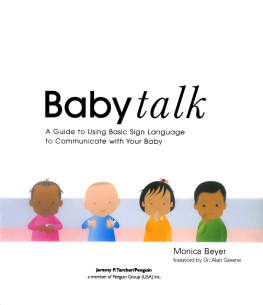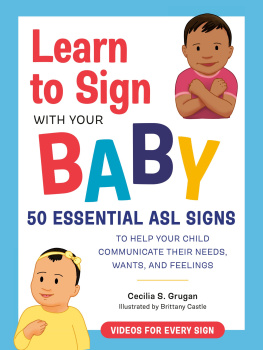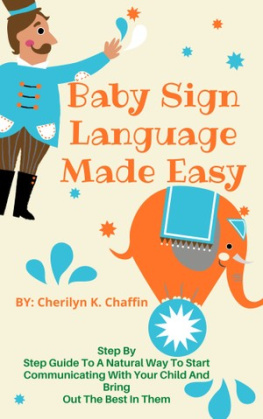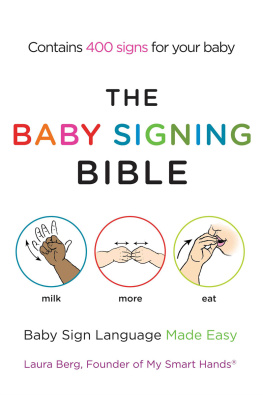Baby talk
Baby talk
A Guide to Using Basic Sign Language to Communicate with Your Baby

Monica Beyer
foreword by Dr. Alan Greene
Jeremy P. Tarcher/Penguin
a member of Penguin Group (USA) Inc.
JEREMY P. TARCHER/FENGUIN
Published by the Penguin Group
Penguin Group (USA) Inc. 375 Hudson Street, New York, New York 10014, USA
Penguin Group (Canada) 90 Eglinton Avenue East, Suite 700, Toronto, Ontario M4P 2Y3. Canada (a division of Pearson Penguin Canada Inc.)
Penguin Books Ltd, 80 Strand, London
WC2R ORL, England
Penguin Ireland, 25 St Stephens Green, Dublin 2, Ireland
(a division of Penguin Books Ltd)
Penguin Group (Australia), 250 Camberwell Road, Camberwell, Victoria 3124, Australia (a division of Pearson Australia Group Pty Ltd)
Penguin Books India Pvt. Ltd.
11 Community Centre, Panchsheel Park, New Delhi110 017, India
Penguin Group (NZ), Cnr Airborne and Rosedale Roads, Albany, Auckland 1310, New Zealand (a division of Pearson New Zealand Ltd)
Penguin Books (South Africa) (Pty), Ltd 24 Sturdee Avenue, Rosebank, Johannesburg 2196, South Africa
Penguin Books Ltd, Registered Offices, 80 Strand, London WC2R ORL, England
Copyright 2006 by
The Ivy Press Limited
This book was conceived, designed and produced by
The Ivy Press Limited
The Old Candlemakers
Lewes, East Sussex BN7 2NZ, UK
All rights reserved. No part of this book may be reproduced, scanned, or distributed in any printed or electronic form without permission. Please do not participate in or encourage piracy of copyrighted materials in violation of the copyright holders rights. Purchase only authorized editions.
Published simultaneously in Canada
Most Tarcher/Penguin books are available at special quantity discounts for bulk purchase for sales promotions, premiums, fund-raising, and educational needs. Special books or book excerpts also can be created to fit specific needs. For details, write Penguin Group (USA) Inc. Special Markets, 375 Hudson Street, New York, NY 10014.
An application to register this book for cataloging has been submitted to the Library of Congress.
ISBN 1-58542-517-6
Creative Director: PETER BRIDGEWATER
Publisher: JASON HOOK
Editorial Director: CAROLINE EARLE
Art Director: SARAH HOWERD
Senior Project Editor: HAZEL SONGHURST
Designer: JANE LANAWAY
Illustrator: MARK JAMIESON
Publishers Note
While the author has made every effort to provide accurate internet addresses at the time of publication, neither the publisher nor the author assumes any responsibility for errors, or for changes that occur after publication. Further, the publisher does not have any control over and does not assume responsibility for author or third-party websites or their content.
Authors Note
In this book, I alternate between baby boys and baby girls and speak of mothers and fathers as primary caregivers. However, feel free to mentally adjust for your personal family situation. Also keep in mind that babies vary in their speed and ability to learn as much as they do physically, and if you ever have any developmental questions or concerns, please consult your childs physician.
foreword
By Alan Greene, M.D., FAAP
I ve been a fan of signing with babies for years. As a pediatrician, when I settled in to read Babytalk I had questions in mind. Are the books ideas about teaching basic sign language to babies developmentally and age appropriate? Are the instructions easy to follow? Would I recommend this book to parents and caregivers in my own practice? The answer is yes!
Whats more, I found myself thinking This looks fun. As parents, you want to do all the right things. We become so busy, however, that sometimes having fun gets lost in our long lists of must-dos. The beauty of Babytalk is that it rolls cognitively and physically stimulating play, communication, and bonding into the same activity. Importantly, its an activity that you and your child can take at your own pace. As author Monica Beyer makes clear, teaching your baby sign language is not about power-parenting, its another loving way to interact.

Your baby uses body language to communicate with you from day one. One of the most fulfilling firsts is that ah-ha moment you recognize what your baby is trying to tell you. Yes! you think with love and relief. Were communicating.
Teaching your baby sign language is a way to extend and refine his or her own nonverbal talk. Your baby will discover many things he or she wants to express before being able to verbalize them fully. With consistency and patience, through sign language you can help your baby bridge the communication gap that occurs while speech develops. On your communication journey, theres no way to avoid misunderstandings and upsets altogether. However, if by learning this beautiful, fluid language you achieve a higher level of communication and allay even a small amount of parent-child frustrationand you have fun togetherwhat a great idea!
In Babytalk Monica Beyer takes this great idea and makes it easy to understand. She explains the process in a clear, warm way, with just enough repetition of the key points to reassure parents: Yes, my baby and I are doing this right. She takes you from first steps that focus on early Need-Based Signs (milk, eat, more) and High-Impact Signs (mother, father, dog) to more advanced signing for toddlers onward. She quotes enough experts to show that the book is based on a solid foundation without letting technical talk distract from the process or the fun.

Throughout the book youll find helpful stories from signing parents including the author and her daughter, Lauren. These real-life stories will amaze and inspire you, and collectively they offer a balanced benchmark for realistic expectations.
Learning sign language is a journey your whole family can make. You and your baby learn your first handful of signs. The family is curious. You explain. Soon, siblings, grandpa, and other important caregivers join in: Lets eat, Cookies, Dad, Grandma, I love you. No one is ever too old for a little Babytalk.
So, settle in and enjoy the processits good for you.
ALAN GREENE, M.D., FAAP
Author From First Kicks to First Steps and DrGreene.com.
Division of General Pediatrics, Lucile Packard
Childrens Hospital at Stanford University.
Introduction
signing with babies
S igning with babiesis it the new fad? Something only power moms who want superbabies do? A surefire way to form a speech delay? You may already know that the answer to all of the above questions is a resounding NO!
People have been signing with their babies for years. The most common reason for doing so is an intense desire on the part of a parent or caregiver to find out exactly what is going on in a babys mindwhat does she need? What does she want? What does she observe? What does she think about and remember?
natural expression
Infants develop the fine muscles in their hands before they develop those required for speech, so theyre equipped to communicate with you before they can speak. Most babies will invent their own signs to get their meaning across. A baby may learn to wave bye-bye, for example, or point to her nose when it needs a wipe. These symbolic gestures are one form of communication used by preverbal infants. In addition to pointing and grunting, a baby has the potential use of her hands and body to help her communicate.













